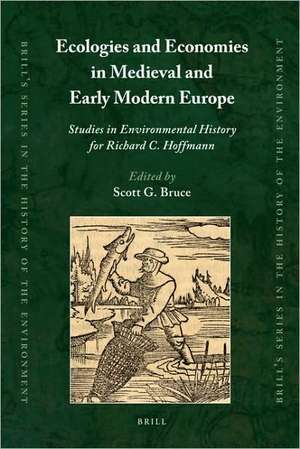Ecologies and Economies in Medieval and Early Modern Europe: Studies in Environmental History for Richard C. Hoffmann: Brill's Series in the History of the Environment, cartea 1
Scott Bruceen Limba Engleză Hardback – 24 feb 2010
Contributors are Richard W. Unger, Paolo Squatriti, William Chester Jordan, Petra J.E.M. van Dam, Verena Winiwarter, Maryanne Kowaleski, Constance H. Berman, Pierre Claude Reynard, Wim Van Neer, and Anton Ervynck.
Preț: 631.23 lei
Preț vechi: 769.80 lei
-18% Nou
Puncte Express: 947
Preț estimativ în valută:
120.82€ • 131.29$ • 101.56£
120.82€ • 131.29$ • 101.56£
Carte indisponibilă temporar
Doresc să fiu notificat când acest titlu va fi disponibil:
Se trimite...
Preluare comenzi: 021 569.72.76
Specificații
ISBN-13: 9789004180079
ISBN-10: 9004180079
Pagini: 233
Dimensiuni: 155 x 235 x 23 mm
Greutate: 0.52 kg
Editura: Brill
Colecția Brill
Seria Brill's Series in the History of the Environment
ISBN-10: 9004180079
Pagini: 233
Dimensiuni: 155 x 235 x 23 mm
Greutate: 0.52 kg
Editura: Brill
Colecția Brill
Seria Brill's Series in the History of the Environment
Cuprins
Acknowledgements
List of Figures and Tables
List of Contributors
Preface: Richard C. Hoffmann, an Appreciation Scott G. Bruce
Introduction: Hoffmann in the Historiography of Environmental history Richard W. Unger
Part One Premodern People and the Natural World
Trees, Nuts, and Woods at the End of the First Millennium: A Case from the Amalfi Coast Paolo Squatriti
The Great Famine: 1315-1322 Revisited William Chester Jordan
Rabbits Swimming across Borders: Micro-environmental Infrastructrres and Macro-environmental Change in Early Modern Holland Petra J.E.M. van Dam
The Art of Making the Earth Fruitful: Medieval and Early Modern Improvements of Soil Fertility Verena Winiwarter
Part Two Aquatic Ecosystems and Human Economies
The Seasonality of Fishing in Medieval Britain Maryanne Kowaleski
Reeling in the Eels at la Trinquetaille near Arles Constance H. Berman
Reaching for a 'Natural Authority': The Rhone in Eighteenth-Century Lyon Pierre Claude Reynard
Defining 'Natural' Fish Communities for Fishery Management Purposes: Biological, Historical, and Archaeological Approaches Wim Van Neer and Anton Ervynck
Appendix: Richard C. Hoffmann: Works Published 1971-2008 Compiled by Scott G. Bruce with the help of Ellen Hoffmann and Jean Levy
Index
List of Figures and Tables
List of Contributors
Preface: Richard C. Hoffmann, an Appreciation Scott G. Bruce
Introduction: Hoffmann in the Historiography of Environmental history Richard W. Unger
Part One Premodern People and the Natural World
Trees, Nuts, and Woods at the End of the First Millennium: A Case from the Amalfi Coast Paolo Squatriti
The Great Famine: 1315-1322 Revisited William Chester Jordan
Rabbits Swimming across Borders: Micro-environmental Infrastructrres and Macro-environmental Change in Early Modern Holland Petra J.E.M. van Dam
The Art of Making the Earth Fruitful: Medieval and Early Modern Improvements of Soil Fertility Verena Winiwarter
Part Two Aquatic Ecosystems and Human Economies
The Seasonality of Fishing in Medieval Britain Maryanne Kowaleski
Reeling in the Eels at la Trinquetaille near Arles Constance H. Berman
Reaching for a 'Natural Authority': The Rhone in Eighteenth-Century Lyon Pierre Claude Reynard
Defining 'Natural' Fish Communities for Fishery Management Purposes: Biological, Historical, and Archaeological Approaches Wim Van Neer and Anton Ervynck
Appendix: Richard C. Hoffmann: Works Published 1971-2008 Compiled by Scott G. Bruce with the help of Ellen Hoffmann and Jean Levy
Index
Notă biografică
Scott G. Bruce, Ph.D (2000) in History, Princeton University, is Associate Professor of Medieval History at the University of Colorado at Boulder. He has published widely on topics related to the abbey of Cluny, including a book entitled Silence and Sign Language in Medieval Monasticism: The Cluniac Tradition, c. 900-1200 (Cambridge, UK, 2007).
Recenzii
"Though we have an increasingly cohesive community of pre-modern environmental historians, connected to each other through conferences and joint projects (like this volume), we are not cohesive, and have many different scholarly interests and backgrounds. This topical and methodological diversity is, I would suggest, a hallmark of the field, and this collection of essays highlights the many perspectives that are brought into play. One of the good things about this variety is that it is bound to introduce medieval environmental history to a wider range of readers, who might pick up the book for any number of interests ancient agriculture, the history of the Rhone, past species diversity, and modern fisheries restoration, to name but a few. And the essays, individually, are of high quality, detailed in their discussion of methodology, and representative of the work of the scholars, all leaders in their respective fields. [...] The multidisciplinarity of this volume stands out – both in the topics and methodologies represented in the articles and in the academic backgrounds and research fields of the contributors. [...] Ultimately, the reason for non-specialists to turn to this book is the deft way that it demonstrates that the pre-modern past is not only interesting in its own right, but can also be connected to the concerns of the present." - Ellen Arnold, Ohio Wesleyan University, posted on November 13, 2013





